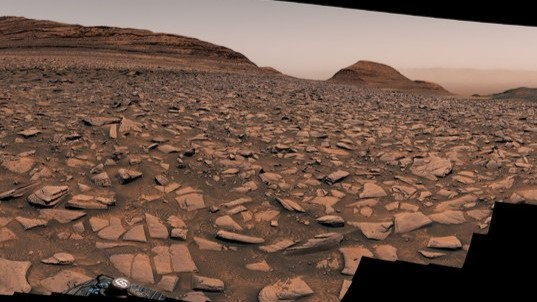NASA's Curiosity rover captures 360-degree view of Mars — and finds strange sulfur stones
The 360 degree view reveals new mysteries from the floor of the Gediz Vallis.

For twelve years, we've watched Curiosity crawl its way over the rocky surface of Mars, decoding mysteries of the Red Planet and broadcasting back home pictures and data from the strange Martian environment.
The Mars rover, built by NASA's Jet Propulsion Laboratory (JPL), has slowly scaled Mount Sharp since 2014. This mountain, officially monikered "Aeolis Mons," was discovered in the 1970s; cut into its alien landscape is the boulder-packed Gediz Vallis channel, which some scientists believe to be an ancient river bed.
Curiosity crossed into Gediz Vallis earlier this year — and, yesterday, JPL released a real treat for Mars lovers: a 360-degree panorama view of the Gediz Vallis channel.
You can play the YouTube video and move your phone around for the nifty interactive feature. Or, if you're using a desktop PC, you can shift the video around with a mouse.
Related: Little Mars 'snowman' spotted by NASA's Perseverance rover (photo)
The view shows a number of the Martian features that surround the Gediz Vallis channel, including Kukenán Butte, Pinnacle Ridge, Texoli Butte and even a distant glimpse of Gale Crater Rim.
Exactly how the channel came to be is currently up for debate among scientists. It's possible water flowed through it some eons ago, or that strong winds are responsible for the formation Or, perhaps landslides cascading down from Mount Sharp's higher elevations created Gediz Vallis, which could explain the boulders and debris Curiosity has found along its trip.
Get the Space.com Newsletter
Breaking space news, the latest updates on rocket launches, skywatching events and more!
Among the debris are mysterious white sulfur stones, which are labeled in the panoramic view JPL provided. The rover also rolled over one of the white stones and cracked it open. Inside the crushed stone were yellow crystals of sulfur. Because the sulfur on Earth comes from hot springs and volcanoes, neither of which have been found on Mars, the JPL team has yet to come up with an explanation for the element's existence on the world.
"We looked at the sulfur field from every angle — from the top and the side — and looked for anything mixed with the sulfur that might give us clues as to how it formed," said Curiosity’s project scientist Ashwin Vasavada in a statement. "We've gathered a ton of data, and now we have a fun puzzle to solve."

After over a decade of hard travels, Curiosity remains functional, if somewhat beat up from the tough Mars surface. The rover's next destination, a formation of weblike patterns called "the boxwork," lies further along Mount Sharp. First glimpsed in 2006 by NASA’s Mars Reconnaissance Orbiter, the boxwork spans six to 12 miles and could be the result of minerals carried by water into fractures along the mountain's surface.
"These ridges will include minerals that crystallized underground, where it would have been warmer, with salty liquid water flowing through," Kirsten Siebach, a Curiosity scientist who's studying the region, said in a statement. "Early Earth microbes could have survived in a similar environment. That makes this an exciting place to explore."
As Curiosity begins its journey to study the boxwork, JPL's scientists will use the data they've received to put together theories on how the features within the Gediz Vallis channel were formed. Now, the science team is forming a timeline of events, based on what Curiosity observed during its travels.
Join our Space Forums to keep talking space on the latest missions, night sky and more! And if you have a news tip, correction or comment, let us know at: community@space.com.
Julian Dossett is a freelance writer living in Santa Fe, New Mexico. He primarily covers the rocket industry and space exploration and, in addition to science writing, contributes travel stories to New Mexico Magazine. In 2022 and 2024, his travel writing earned IRMA Awards. Previously, he worked as a staff writer at CNET. He graduated from Texas State University in San Marcos in 2011 with a B.A. in philosophy. He owns a large collection of sci-fi pulp magazines from the 1960s.
-
MeS Reply
From the article:ImmortalMelvz said:The presence of sulfur means there was a volcanic activity that happened.
"Because the sulfur on Earth comes from hot springs and volcanoes, neither of which have been found on Mars, the JPL team has yet to come up with an explanation for the element's existence on the world."
The difference between the scientific method and the non-scientific is: you don't get to pick the most probable answer without evidence. What you have is an opinion, though you stated it as a fact.











